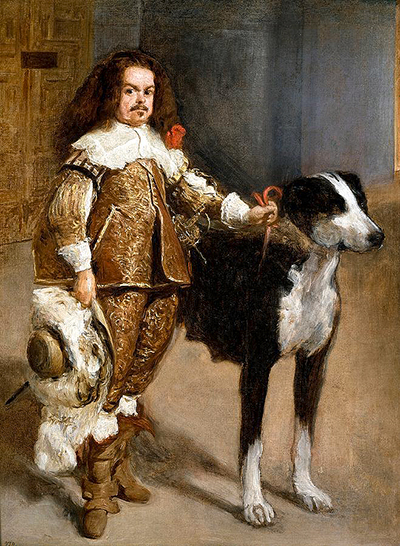Man and Dog are shown here in all their glory, in another full length portrait from the career of Spanish artist Diego Velazquez. This was a man who was particularly skilled in the precise depiction of clothing and drapery, helping to bring to life the stunning outfit worn by this gentleman.
The Buffoon, as indicated by the title of this painting, stands on our left, looking directly at us. He wears traditional clothing, complete with beautifully embroidered patterns that delight our eyes, particularly for those fortunate enough to the piece up close in person. He takes off his hat for the portrait and holds it in his right hand side, which hangs by his side. In his left hand he holds a red lead for the dog, which looks extraordinarly large in comparison to himself. The dog calmly stares off to the right of us, standing still but looking strong and confident, almost like the horses found in military and royal depictions of around this period, such as Velazquez's own Philip IV on Horseback and Equestrian Portrait of the Count Duke of Olivares.
Velazquez was a capable artist when it came to paintings animals, but this remains a specialist field which does not directly relate to portraits of humans, or not at least as closely as one might imagine. You will find in the examples of artists like George Stubbs that specialist skills could only be developed by taking the time to study each creature individually, just as he had done by getting hold of carcasses. The same could also be seen in the work of Delacroix, and whilst Stubbs specialised in horses, Delacroix spread his net a little wider, but was particularly well known for exotic creatures, such as with his Arabs Skirmishing in the Mountains, Lion Hunt in Morocco and The Battle of Giaour and Hassan. Stubbs' highlight remains the extraordinary and uplifting Whistlejacket. Velazquez himself tended to portray horses and dogs and not much else, and these two helds important roles within society at that time, just as they still do today.
This painting is owned by the Prado Museum and they actually choose to refer to this piece as Dwarf with a Dog instead. They have put a date on it as circa 1645, with most of this artist's paintings loosely dated in that way because of the relative lack of documentation that survives from his career. It is only the royal portraits which can be more accurately dated, as we have much more information about the lives of those featured that the gentleman found her. Dwarfs were actually quite popular for portraits during this period in Spanish art, far more than they are today, though in the present era we would certainly choose a more socially minded term than this. Their use would often be with the intention of reflecting something onto other figures that they would stand next to, such as symbolic or even merely acting as a means of scale, making the more important figure look larger and stronger. It is hard to imagine anyone doing this today, as many would consider it patronising or discriminatory, but these types of paintings are important in reminding us of how societies of the past were quite different in all manner of ways.




